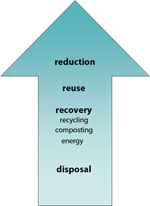22.3 Integrated solid waste management

The concept of integrated solid waste management (ISWM) mostly applies to municipal solid waste management in urban centres. The principles can, however, be applied to some extent in rural and peri-urban solid waste management.
In Study Session 18, it was explained that an ISWM approach means considering not only the appropriate disposal of solid waste but integrating this with other management options such as minimising waste production, recycling, composting and other waste recovery options. These different options can be ranked in order of their desirability as management options. This is often represented in a diagram known as the waste management hierarchy (Figure 22.3) that you first met in Study Session 2.
At the top of the hierarchy is reduction, which means keeping the production of waste to a minimum. Next comes reuse, which simply means using something more than once. The third option in the hierarchy is recovery, which includes several separate processes that enable material or energy resources to be recovered from the waste. These include recycling, composting and energy from waste. Finally, the least desirable waste management option is disposal, which includes landfill, tipping and incineration (burning) without energy recovery.
We will now look at the options for waste management in the hierarchy in a little more detail.
22.2.4 Disposal of solid waste
